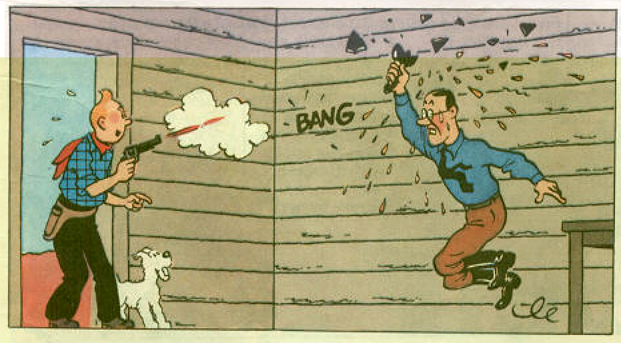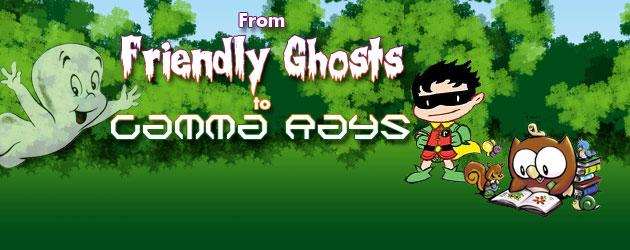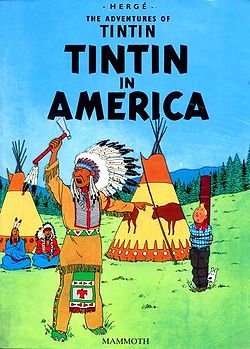
Welcome back to another extra edition of From Friendly Ghosts To Gamma Rays, where we have part 3 in our series looking at Herge’s entire body of work on The Adventures of Tintin, as we near the film opening up here in the United States in December, directed by Speilberg and produced by Peter Jackson (those in Europe only have to wait until the end of October, lucky guys over there). Today we look at the third story arc, Tintin in America.
Originally published in Le Petit Vingtieme from 1931 to 1932 under the story arc Tintin en Amerique (translated as Tintin in America), the story starts with our favorite reporter and his dog visiting America. Al Capone, based off the then living real life gangster, has caught wind of this and, still angry Tintin broke up his diamond racket in the last story arc, Tintin in the Congo, sends an array of gangsters to kill Tintin and Snowy. While going up against Capone, Tintin crosses paths with Bobby Smiles, a gangster who is a rival to Capone. Tintin, pure of heart, tries to turn the tables on Smiles, but immediately finds himself in a series of plots trying to be killed by Smiles; including being whisked out West and almost taken out by a group of Native Americans tricked into thinking Tintin is the bad guy, made into lunch meat at a cannery, drowned, and a handful of other attempts. By the end, Tintin and Snowy make it out with a few more than lucky/humorous breaks, and a few families of gangsters are turned over to the police making the streets of depression era Chicago a little more safe. Tintin and Snowy jump back on ship to Europe as America fades into the distance.
The strip was collected in 1932 and then redrawn/colorized for an edition in 1945. In 1962 it received its English translation, and finally in 1973 would be released here in the United States. Like the first two Tintin tales, Herge didn’t visit America before this, and based his facts on the country from one or two travel books and what people in Europe said of the U.S. at the time (Herge wouldn’t research in-depth his locations until the story arc The Blue Lotus, which we’ll get to in the future). So Herge redrew/colorized it, as in other Tintin collections, and he edited a few things, specifically drawings of both African Americans and Native Americans, that weren’t considered socially acceptable anymore. In the English version of the text, he edited out talk of “lynching Negroes,” something Europeans believed happened on a daily basis in the United States (writers note: yes, unfortunately this did happen frequently before the U.S. Civil War, but was outlawed after, so period wise this doesn’t match up).
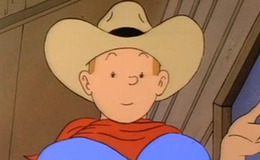
The version of Tintin in America available to English readers as mentioned is the colorized/redrawn version, so artwork wise Tintin looks like Tintin and Snowy looks like the Snowy we know and love, finally. If you run into a unique black and white original version, Herge is on the cusp of fine-tuning their looks. The story also goes at rapid fire pace and shifts into the full gear, more action than laughs. I believe it feels quicker because when Herge did the 1945 version, Tintin in album form could only be 62 pages, and so the reworking often cut out blocks, condensed action, and put the content of original multiple strip pages onto a strip page. Two interesting historic notes are also here in these pages. The first is Al Capone’s appearance in both this and the previous Tintin in the Congo, making Al Capone the only real life historical figure to appear in The Adventures of Tintin. Also is Herge’s personal fascination with Native Americans since his days as a young Boy Scout. By setting the story in America, it gave Herge a great subplot to give Tintin a wild west-type of adventure and include Native Americans. For as vengeful as he makes the Native Americans seem when they attack Tintin, Herge also depicts their troubles at the time in the States with a segment where when oil erupts, businessmen offer Tintin thousands of dollars for it. Tintin explains it’s not his land but the Native Americans, so the tribe is offered 25 bucks and then forced off the land by the government.
Tintin in America is the strongest thus far of the tales when we start at the top of Tintin’s story arc. It is the first story where from the get go we have what we can consider a defined plot that travels throughout the whole story, as compared with the previous two that felt more like Herge made up his mind week by week as he went along. The action is exciting, the art is great, and of course there are a few laughs along the way. Tintin in America is pretty great. It’s also a good jumping on point for those who haven’t read the first two Tintin stories, which can feel a bit polarizing for some (in fact in America, it is the first book numbered of the Tintin series and the easiest to find). Worth checking out. See you next edition when we look at Cigars of the Pharaoh.
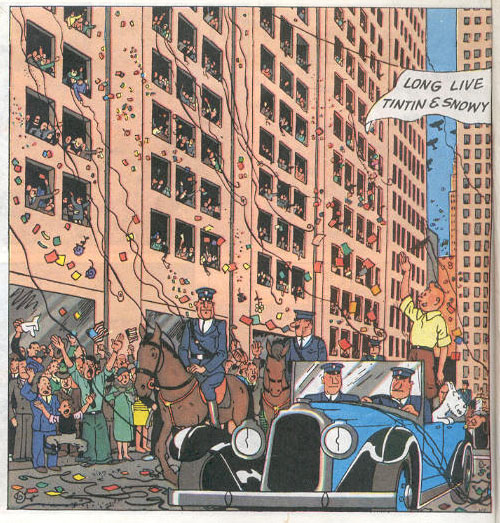
Read Part One: Land of the Soviets
Read Part Two: That Old Fashion Congo!
Drew McCabe
drew@comicattack.net
